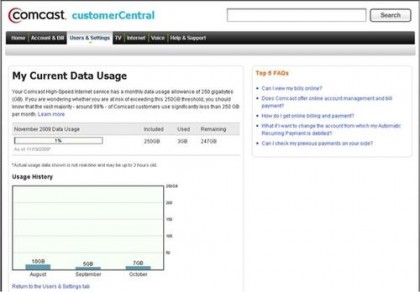Comcast made its big DOCSIS 3.0 push last year and boosted downstream speeds in most markets to 50 Mbps. According to Broadband Reports, however, the operator will go a step further and bring 100-Mbps speeds to 20% of its subscriber base by the end of 2010. And that’s just the beginning. Also on the horizon are downstream speeds up to 250 Mbps. That won’t happen this year, but a source suggests it’s not too far off either.
Does anybody really need speeds that high? And can networks support that much data usage? In answer to the first question, there’s room for experimentation with higher speed networks. Jokes about teleportation aside, we haven’t yet fully explored the possibilities of using a massively fast pipe for video conferencing, 3D modeling, medical applications, and more. Google certainly sees opportunity, hence the company’s announcement earlier this month that it will deploy fiber networks with speeds up to 1 Gbps in a few test locations.
In answer to the second question, well, it’s not entirely clear yet. We’ll have a better sense if and when we can examine data about actual consumer broadband usage. That may be easier once there are better measurement tools on the market. On that front, Comcast is making progress. After Dave tweeted the news that the operator’s bandwidth meter had made its way to the Boston market, Jeff Baumgartner went on to discover that Comcast has extended its bandwidth meter trials to some Seattle customers as well, and plans to add parts of Connecticut, New Hampshire, Massachusetts, Minnesota, and Texas to the mix by the end of this month. Parts of Utah and Colorado should follow soon afterward.
As consumers get a better read on their own usage, I’m betting we’ll start to see better aggregate data too. Bandwidth caps are one thing, but actual usage data will help us figure out if networks are up to the job of supporting higher throughput. Especially once higher speeds become less of a novelty, and demand for consistently higher throughput spreads through larger portions of the population.

I finally gave up waiting for the long-promised meter and bought a router with the capability to monitor your usage built in, the Netgear Rangemax WNDR3700 Dual Band Wireless-N Gigabit Router. Either that or that power surge that took out my previous Wifi router might have had something to do with it. Anyway, I can now at least see what I’m using.
If you actually started to live a digital TV life and watched most/all of your TV via online streaming or downloads, you could easily justify speeds in the multiple 10’s of Mbps. Not sure I can currently see why I’d need more than 50Mbps, but its nice to know its out there. As always though the question won’t be whether it exists or not, it’ll be how much Comcast wants for it.
They are posting their burst speeds which is only for the first 10MB of data when you are the only one on the shared network. After that, you are throttled to an unpublished speed, and then once you hit their monthly data cap, you are further throttled.
It’s all marketing speak. They’ve probably had the capability to do 50Mb for awhile and marketing simply raises the cap every so often to make it appear that their networks are getting faster which gets customers and blogs all excited and they get good press for it.